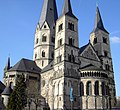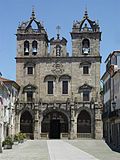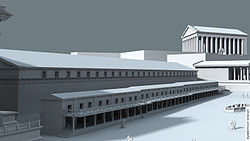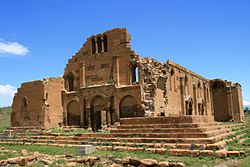Basilica

A basilica is a large, important church. The word can also be used for an Ancient Roman building that was used for law and meetings. The word "basilica" is Latin which was taken from the Greek "Basiliké Stoà".
Nowadays the word is used in three ways:
- A Roman Catholic church that has been given the right to use that name, by the Pope. Only some large important churches have this right.
- An Ancient Roman basilica
- People who write about architecture often use the word "basilica" to mean a building that is shaped like an Ancient Roman basilica.
History
Ancient Rome
A Roman basilica was a large hall built for meetings, business and law. A Roman basilica usually had the doors at the long sides of the building. At each end was a semi-circular part where the judges sat. The building usually had two rows of columns, which made a high central part and a lower aisle on either side. The light came in from windows above the columns. As the Roman Empire spread, every city had a basilica.
Early Christian basilicas
Early in the 4th century (312 AD), the Roman Emperor Constantine made Christianity the legal religion of the Roman Empire. The Christians who had been worshipping secretly in private houses now wanted to build churches. They did not want the churches to look the same as Roman Temples. They built them to look more like Roman Basilicas. A basilica was a good plan for a Christian church because lots of people could fit inside, and the aisles were useful for people to move around. The semi-circular part at one end, the apse, was just right to put the altar. Christian basilicas usually have the door at one end, rather than at the side. In front of the door there was often a courtyard called an atrium. Most of these atriums have gone, but churches often have a town square or a market place in front of them.
Some of the oldest Early Christian basilicas were four that were begun in Rome by the Emperor Constantine. Three of them are still standing, but they have had many changes in the last 1,700 years. These are the basilicas of Santa Maria Maggiore, St. John Lateran and St. Paul's outside the Walls. The fourth basilica was 'Old St. Peter's which was replaced in the 16th and 17th centuries by the present St. Peter's Basilica. Other Early Christian Basilicas were built in Greece and the Holy Land.
Present-day basilicas
Some basilicas are called "Ancient Basilicas". These have been called basilicas since Early Christian or Medieval times. It is their traditional name. Ancient Basilicas include the Church of the Holy Sepulchre in Jerusalem, the Basilica of San Vitale in Ravenna and the Basilica of San Lorenzo in Rome. The four other ancient basilicas of Rome are called the "Major Basilicas". Each Major Basilica has a throne for the pope and an altar that is specially for the pope to celebrate mass. No-one else can use that altar without the pope's permission. All the other basilicas are called "Minor Basilicas".
Nowadays, for a church to be called a Minor Basilica, it has to be given some special privileges or rights by the pope in a document called a "Papal Brief". When a church has been made a basilica, the clergy then carry some special symbols when they are in procession. In 2008 there were more than 1,600 basilicas in the world.
Why do churches become basilicas?
Ancient basilicas
Many churches are given the name "basilica" to show that they are special in some way. There are very few ancient basilicas that were built on ground associated with Jesus. They are thought of as some of the holiest Christian sites in the world. These include the Basilica of the Annunciation in Nazareth, the Basilica of All Nations where Jesus prayed on the Mount of Olives and the Basilica of the Holy Sepulchre in Jerusalem. The Basilica of the Holy Sepulchre is very unusual because the church is shared by the Catholic and Orthodox Churches.
Martyrs
Other ancient basilicas are places where a saint was martyred (put to death). One of these is the Basilica of Saint Stephen, the first Christian Martyr, which is also in Jerusalem. There are many ancient basilicas which were built on the place where a saint was buried. In Rome there are many basilicas like this, because Rome was a very big city, with many Christian people. The Emperors thought Christianity was dangerous to them, because Christians put the rules of Jesus before the law of the Emperor. Many Christians were martyred. When Christianity became legal, churches were built over the graves of martyrs. These churches often became known as basilicas, because they were in the shape of a Roman basilica. Basilicas built over tombs of martyrs include Sant'Agnese outside the Walls, San Lorenzo outside the Walls, and St. Paul's outside the Walls. The words "outside the walls" mean that the burial place of the saint was outside the walls of the city.
Relics
Some basilicas are famous because they have "relics" (or bones or perhaps a body part) of a saint. It could also be the case that the relics were reinterred from the original place. If a church housed the body of an important saint, then many people would come on pilgrimage and would dedicate themselves to prayer and the use of the sacraments. Basilicas that have bodies include St. Mark's, Venice, St. Nicholas of Bari, also in Italy, and the Basilica of St. Mary Magdalene in Vezelay, France. Not all relics are bodies. Basilicas may also hold a famous object like a piece of the True Cross, or the belt worn by the Virgin Mary. People often ask whether all these precious relics are authentic. The Roman Catholic Church does not get into arguments about trying to prove whether the pieces of the Cross, the body parts and other things are real. Sometimes the relic is known to be real. Sometimes there is no way to prove it, either way.
Saints
Other basilicas are churches that were built by a famous saint, were used by a famous saint, or were built to honour the saint, who did not die as a martyr but lived a very holy life. Two of the most famous basilicas of this sort are the Basilica of St. Francis of Assisi and the Basilica of St. Anthony of Padua. Many thousands of pilgrims go to these churches every day to remember two saints who were gentle, humble and taught people to live better lives.
Signs and Miracles
Some basilicas are built because a miracle or special sign took place. The sign might be a vision and might give a plan to build. The Basilica of Lourdes in France is built at the place where Bernadette Soubirous had a vision of the Virgin Mary. It is an important pilgrimage place. Sometimes the sign is not so strange as a vision. In the Philippines, the Basilica del Santo Niño was built at the place where a partly burnt box was found in 1565. It contained a little statue of the Christ Child and had been left behind by some Spanish or Portuguese explorers many years earlier. "Santo Niño" means "Holy Child" in Spanish.
Well-known basilicas
Major basilicas
The four great Basilicas of Rome, as well as having a seat and an altar for the pope, have a Holy Door which is only opened for special occasions such as a Jubilee Year.
- The Basilica of St. John Lateran, is also called the Lateran Basilica. It is the cathedral of the Bishop of Rome, the Pope.
- St. Peter's Basilica, also called the Vatican Basilica, is a major pilgrimage site, being built over the burial place of Saint Peter. It is used for most of the main religious ceremonies in which the Pope takes part.
- The Basilica of St. Paul outside the Walls, is also known as the Ostian Basilica, because it is on the road that led to Ostia. It is built over the burial place of Saint Paul.
- The Basilica of Santa Maria Maggiore, (St. Mary Major) is also called the Liberian basilica, because the building was thought to have been built by Pope Liberius. It is the largest church in Rome dedicated to the Virgin Mary.
Other well-known basilicas


- The Church of the Holy Sepulchre, Jerusalem, Israel
- The Basilica of St. Nicholas of Bari in Bari, Italy
- The Basilica of St. Anthony of Padua in Padua, Italy
- The Basilica of St. Francis of Assisi in Italy
- The Basilica of St. Mark in Venice, Italy
- The Basilica of St. Denis, near Paris, France
- The Basilica of St. Louis, St. Louis, Missouri USA
- The Basilica of Our Lady of Fátima, Portugal
- The Cathedral Basilica of San Thome, Chennai, India
- St. Stephen's Basilica, Budapest, Hungary
- The Cathedral Basilica of St. Chad, Birmingham England(1941)
- The Cathedral Basilica Shrine of Our Lady of the Rosary, Argentina
- The Cathedral Basilica of St. Mary, Help of Christians Sydney, Australia
- The Basilica of Our Lady of Peace of Yamoussoukro, in Côte d'Ivoire West Africa
- The Cathedral Basilica of Notre-Dame de Québec in Quebec City was the first basilica in North America. (1874).
- The Cathedral Basilica of Our Lord Jesus Christ King of the Universe, Reykjavík, Iceland
- The Basilica of St. Adalbert in Buffalo, New York United States of America, (1907)
- The Cathedral Basilica of Las Lajas, in Colombia
- Berchem Basilica, Antwerp, Belgium (1878)
- San Francisco de la Habana Basilica in Havana, Cuba
- The Basilica of St. Gereon, Cologne, Germany (1920)
- The Basilica of Our Lady of Lanka, Tewatte, Sri Lanka
- The Basilica of San Isidoro Archived 2012-06-20 at the Wayback Machine, León, Spain
- The Basilica of the Black Nazarene, Philippines
- The Basilica of Emmaus Nicopolis, Israel
- The Basilica of la Sagrada Familia, Spain, has been under construction since 1882, and although it is still unfinished, it was consecrated and proclaimed a minor basilica by Pope Benedict XVI in November 2010
Gallery
The Church of the Holy Sepulchre is an "Ancient Basilica" in Jerusalem.
The Basilica of the Holy Child, Philippines
The Basilica of St. Charles Borromeo is an historic mission church in California.
The Basilica Bom Jesus, Goa, India, contains the Tomb of St. Francis Xavier.
The Basilica of St. Mary, Help of Christians is the first Catholic Cathedral in Australia.
The Basilica of St. Mary, Gdansk, Poland, has been restored after bad damage in World War II.
The Basilica of Our Lady of the Angels in Costa Rica.
The Cathedral Basilica of St Vitus in Prague is built inside the castle walls.
The Basilica of Our Lady of Glory in Brazil was completed in 1972.
The Basilica of Ste Anne de Beaupré, Québec, Canada is famous for healing miracles.
Mariazell Basilica in Austria has a famous statue called the "Great Mother Mary of Austria".
The Basilica of Our Lady of Bruges, Belgium has a statue of the Madonna by Michelangelo.
The Basilica of Bonn Germany was built where two Christian Roman soldiers were martyred.
The modern Basilica of Our Lady of Guadalupe in Mexico City has the famous image of Mary, Patron of the Americas.
The Cathedral Basilica of Braga, Portugal.
The Basilica of La Madeleine Vezelay, France, has a relic of Mary Magdalene.
Basilica in Salta.
Basilica Media
Digital reconstruction of the 2nd century BC Basilica Sempronia, in the Forum Romanum
19th century reconstruction of the 2nd century AD Basilica Ulpia, part of the Trajan's Forum, Rome
Ruins of Yererouk basilica 4th–5th century AD
Reconstruction of the basilica at Fano from a description by its architect Vitruvius
Remains of the 2nd century BC Basilica Aemilia by Giuliano da Sangallo in the 15th century AD
Model of the Antonine basilica on Byrsa Hill, Carthage
Related pages
References
| Wikimedia Commons has media related to Lua error in Module:Commons_link at line 62: attempt to index field 'wikibase' (a nil value).. |
- Architecture of the basilica, well illustrated.
- Basilica Porcia Archived 2019-03-26 at the Wayback Machine
- W. Thayer, "Basilicas of Ancient Rome": from Samuel Ball Platner (as completed and revised by Thomas Ashby), 1929. A Topographical Dictionary of Ancient Rome (London: Oxford University Press)
- Paul Veyne, ed. A History of Private Life I: From Pagan Rome to Byzantium, 1987
- List of All Major, Patriarchal and Minor Basilicas by Giga-Catholic Information
- Catholic Encyclopedia: Basilica & minor parts in other articles
- Richard Krautheimer, Early Christian and Byzantine Architecture
- Domus ecclesiae: Privileges and obligations pertaining to minor basilicas Archived 2016-10-09 at the Wayback Machine































